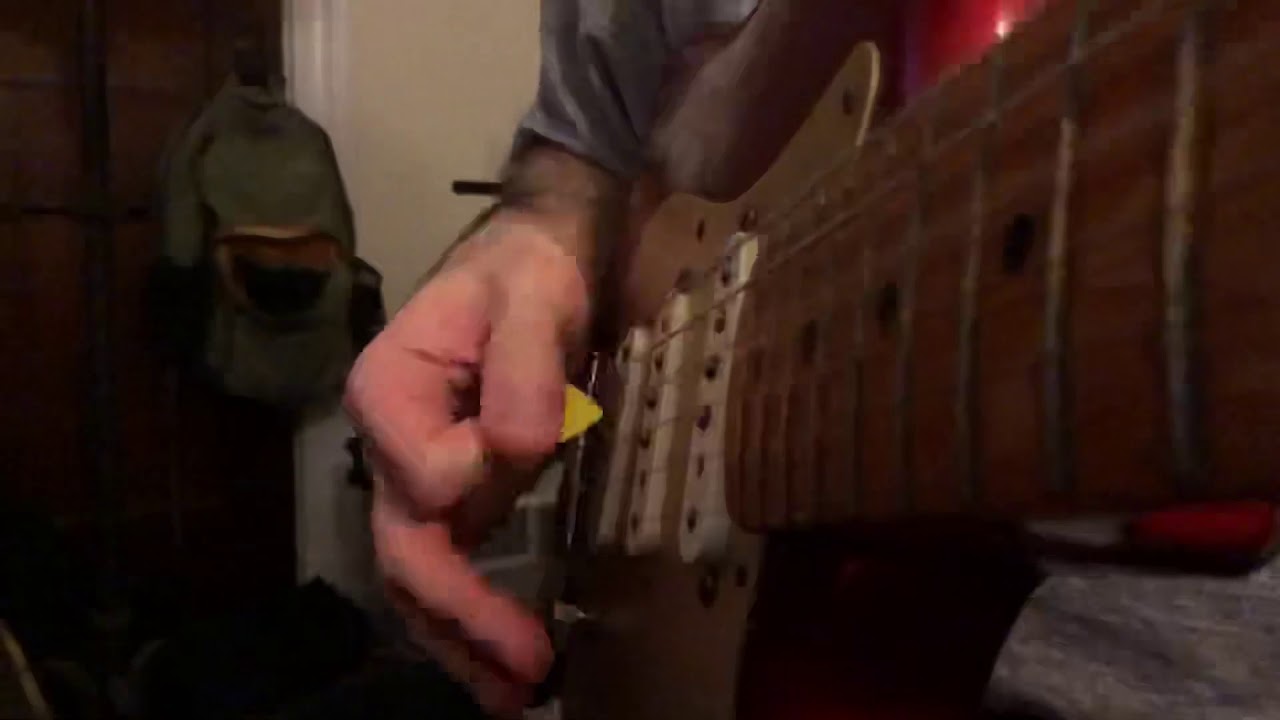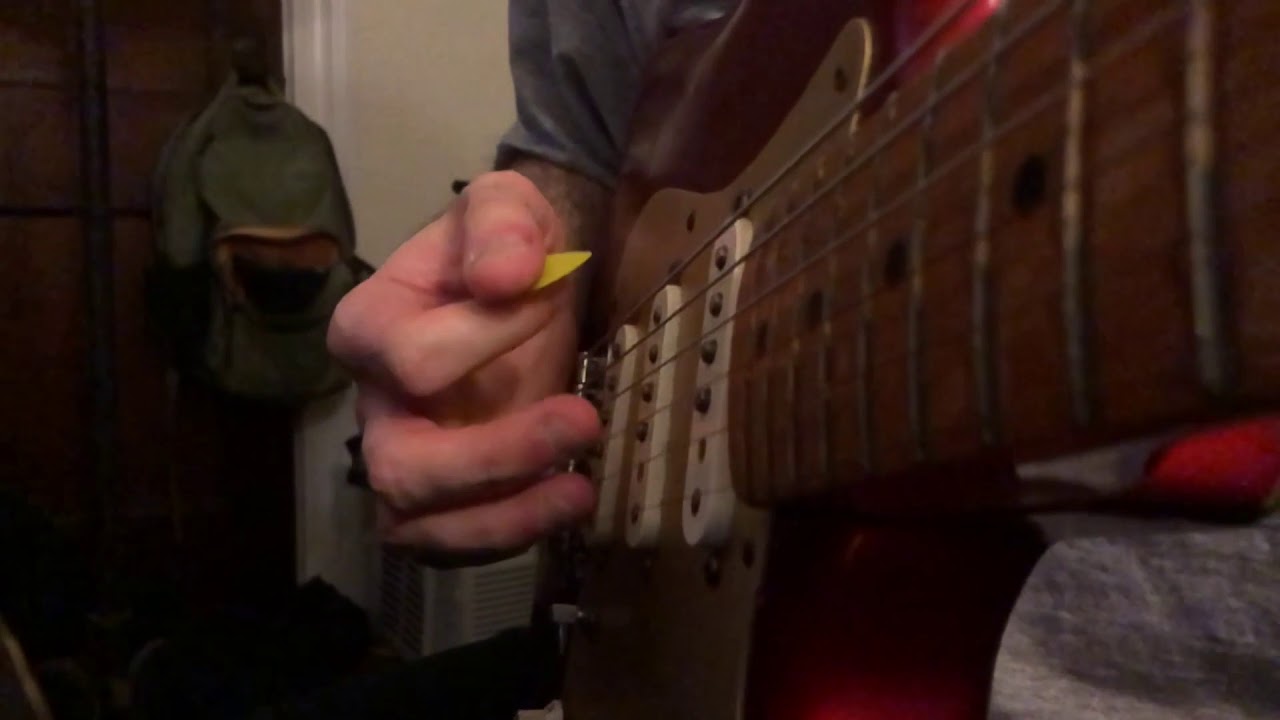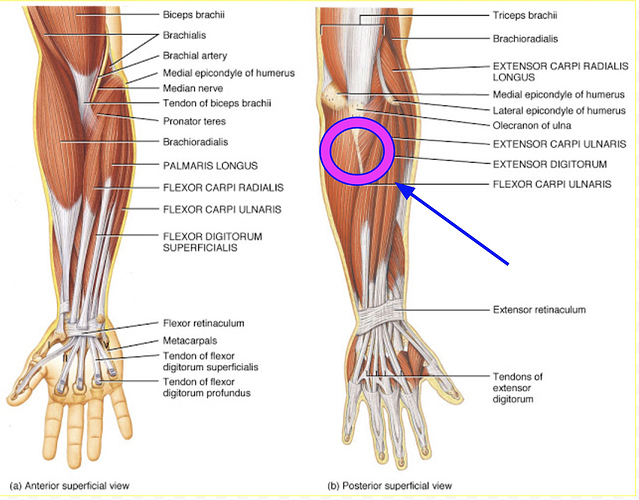Any chance you could post tabs of something that uses this pattern, or maybe a video of you slowly playing one? I’m not too familiar with this style.
Yes, just look up/google Tumeni notes , this kind of movement is used heavily in the first palm muted section shortly into the tune. It’s a beast!
Hi @JakeEstner
which kind of DBX method are you going for? Is it one of the motions (or I guess jointcombinations  ) that there is a tutorial for on the website?
) that there is a tutorial for on the website?
It seems to me that if you are going for the supinated wrist-only DBX your thumb heel is not resting on the strings/bridge like on the tutorials.
If you are going for the forearm-wrist compound motion DBX I think you are not doing the “throttle” or the “motorcycle revving” motion.
I am sure there are other kinds of DBX other than the ones outlined in the content on the website possible. I am no DBX expert myself and just wanted to mention some differences to the tutorial material I noticed.
Fancy trying something for that I have had varying success with?
Pick 3 times per note, but pick at the same speed as youe fast and sloppy version. The duration between string changes will be longer (helps anticipate the string track), but the motion and string change itself will still be fast, with the exact same pick directions.
Its my way of playing the roll slower but quick picking.
I found that it helped me a little at times- I didnt slave away at it, just a minute ir two and then try the normal way. It may not be doing anything other than adding some variation, but hey- worth a shot.
Hi Jake!
This actually looks good. You’re doing the first step correctly, which is fast with no tension. It’s hard to tell with the motion blur but this motion may actually be correct. You have a 120fps mode on your phone right? I recommend using that for all playing clips, even when you post them at normal speed, because that mode has way less motion blur, i.e. 1/120 shutter speed.
If you can do a 120fps version of this and post in regular and slow motion, that will provide a much better look at whether this motion is working.
Edit: I’m specifically referring to the fastest one, since that one seems to be the one you choose for greatest efficiency. The others look like different motions, possibly with some finger action. Not necessarily wrong, but if it’s not what you choose when speed is needed, then maybe that’s a hint that it’s not the most efficient way you know how to move.
@altaykacan good questions and observations, thank you.
@Troy and I dug in pretty deep to my DBX issues in this thread: Trying a double escape again...close up video
and I think from that I concluded - I think - that I’m going for mostly the Andy Wood set up except I find it easier to get a bit of arm involved. That thread was about 6 months ago, and I dug in pretty hard to DBX stuff right after but haven’t been practicing the technique as much more recently.
I did find some things clicking with this approach, ie that basic set up but letting my arm move up and down a bit, and to be honest I think there’s a bunch of moving parts and variables that are hard to isolate and control…I think the conclusion from the earlier thread was basically if it’s feeling good, go for it
For the most part, I’ve had good success since then but admittedly I’ve been more drawn to trying to get comfortable with complex challenges at moderate/moderately-quick tempos rather than getting something simple up to a nice burn.
I guess as of right now I’m not really feeling like there’s a speed limit to the movement, but maybe I just need to practice more, hah! (“if only there were another way!”)
Awesome, thanks Troy.
This is a little dark, but tried to get some view w the different film mode:
Re the different motions at different speeds, in this clip it kind of looks to me like the downstrokes aren’t escaping - like there just needs to be a bit more wrist extension to bring them out?
Thanks for doing this with the better frame rate. This looks great. I can’t really say what’s escaping or not at regular speed. But even if some things aren’t, this is still kind of an ideal starting point in terms of smoothness and efficiency, and light years beyond your original stringhopping clips from a few years back. Do you have a slow-mo version of this you can put up? That will tell us what we need to know.
Here’s the slow version -
I trimmed the non-playing bits, but through the clip I try a few different things with the left hand (like holding a chord down vs just playing 1nps not-ringing-out arpeggios) just because the feel is different and I might be doing something differently.
The pick looks like somebody drunk at a wedding reception staggering table to table to say hello.
I’m noticing the height of my A string there compared to the others and thinking that might be an unnecessary obstacle. But in theory my ‘out-stroke’ should be big enough that a discrepancy that small shouldn’t matter, I guess?
Awesome, thanks for posting this. How are you getting this shot, on a tripod?
Obviously, this is swipey, and the wedding guest analogy is hilarious. But there’s good news here too.
There are moments when downstroke and upstroke motions escape by plenty to get out of the strings, even with the slightly mismatched string heights you’re pointing out. Not only that, but when this happens, these motions are actually the correct ones, i.e. the efficient ones, and not just stringhopping.
So you’re doing what you need to do, you’re just not doing it consistently. And the wedding guest randomness, where some motions overshoot a string or seem to skip certain notes entirely, I think is your hand’s way of trying to figure it all out, and searching for feedback. So I think that’s the key here. You mentioned you don’t have a good sense of when it’s going wrong or right, so more obvious tactile and sonic feedback is what you need to clean this up.
One thing you can do is of course slow down a tiny bit. But you don’t want to do the motion from the other clips, that’s not the same motion. This is the more efficient one, and it appears to be mainly wrist. If you can slow down a small amount but not use the “control” motion, you may have a better shot at hearing when you get notes right.
Another thing is variety. Some patterns will telegraph more when they are correct versus incorrect compared to other patterns. If you do this pattern descending, starting on a downstroke, that will produce inside picking on the highest and lowest strings, and that has a way of being easier to feel and hear when it’s right or wrong.
Other variations you can try are doing this only descending, or only ascending. I like the descending one, starting on a downstroke, again, for the inside picking.
I also like doing this on different groups of strings. The lowest four are particularly hard to hear / feel because they’re lower in pitch and they’re floppy. The upper four and middle four are I think easier to hear when you’re getting it right.
Fretting individual notes rather than letting strings ring can make it easier to hear when it’s right, although that can introduce left-hand muting that unintentionally hides mistakes. But I’d try that too. Patterns like the C-major shape chord are easy for fretting because they’re one finger per fret.
If you can introduce some muting to the strings, either by partially fretting a chord, using a hair band, or some other trick, that’ll make it easier to hear and feel when you’re hitting the strings you want. Eventually you can also try right hand muting like Al Di Meola or Andy Wood, but that’s another variable to worry about that can mess up your form so maybe let’s just stick with what you’ve got.
Finally, I’d try patterns that aren’t this one. Jazz lines that mix 1-, 2-, 3-, and 4-note-per-string fingerings are great because you can’t really “think” those through with single escape motions, so it’s better to just use this approach of going for it and feeling for correctness. Edit: many of those kinds of lines are built on “212” patterns which work great for this kind of practice, like Andy’s take on “Pick It Apart”:
There’s fours in there as well, and that’s another great pattern I’d recommend — descending, starting on a downstroke, for the inside picking, again.
BTW everything I’ve written here is stuff I’ve done and has helped. The more variety you can throw at this, the better. But I think the key is you need more tactile and sonic feedback to hear when notes are correct. And if you can provide that in a very obvious way, it’ll be much easier to feel your way to the correct motions, even if only accidentally. Which frankly, is the only way it ever really works for me.
That’s what I got for now. Let me know if any of this helps!
I’m also a bit swipey on 1nps and what I have noticed is that the difference in height of an open string versus a fretted one is causing the issues more often than not. @Troy, did you ever encounter this as an issue? Am I right to think that the above advice would be apt to me also? Just keep trying muted versions until the string tracking improves and motions sort themselves out? I imagine recording a video would be best, but I struggle to get a good clear shot against my black guitar and seemingly invisible pick! (I dont have any appropriately coloured ones to hand!).
I haven’t noticed this. Maybe as you get really high up the fretboard but even then, if I fret a note at the 17th fret I don’t see much movement by where I’m picking. And I’m not picking super close to the bridge either.
Also, keep in mind that this isn’t even always going to hurt you. If you’re inside picking, the higher action string will be easier to hit, not harder, because you’re going over the top of the string you just played, which is now being pressed lower.
So I think the string height thing isn’t really that much of an issue. Of course we all play better on a guitar that’s set up better, so I always recommend that. Super high strings, and also super low strings that buzz — I don’t like either of them.
Everything I wrote here are just general ways of practicing a wide variety of things to give yourself a shot to get some right, and to really hear and feel when they’re right. I don’t see why these wouldn’t work for anyone using any technique. They’re really not specific to any person or technique.
Cool, thanks for the reply.
Yes, higher up it happens (and I have some serious fret wear that is probably contributing).
A prime example is a decending roll on the high E, B and D strings (missing the unmuted open G string) around 10th fret onwards.
In all fairness its a new roll to me and I can mute it if I need to (I chose not to mute it to give me a dissonant note to hear when I swipe). Sounds like I just need to hit the workshop with it!
Thanks so much Troy, a lot to tool around with there.
Re: tripod, (and @PickingApprentice re: camera angle) yeah I have a little camera stand. since the slowmo camera only works with the rear camera, I also turned on the camera on my laptop , and had the phone and the laptop on my desk so I could see the angle I was getting.
I’ve had some success with this using stools as camera stands (in addition to the adjustable phone mini tripod) but in this case I just awkwardly stood over my big office desk.
Rewatching it I do see those escapes happening ‘ever so slightly’. Seems like it’s more so the downstrokes that seldom ‘leave’ the plane - not sure if that’s a movement thing or maybe a set up thing or a bit of both.
Tooling around with your suggestions a bit the past week I think I run into trouble (possibly via just overthinking, admittedly ) with the balance of working on something vs having the variety.
I don’t know if you can, even arbitrarily, throw out some parameters about things like maybe how long you’d tool around with one of those concepts (for example, 4 note descending then repeat, static chord in left hand) before varying or doing something else.
I tend to get super into tinkering and mapping out different possibilities, and am well aware that I go down those rabbit holes beyond a point of usefulness very often.
At the same time…and this is probably something I should get over, but i get bored as all f*** sitting and playing someone else’s solo for too long.
I made a tool last year that’s been pretty useful, and relevant to this discussion - it basically can generate a ‘random’ riff but based on parameters I input. This has been great for the ‘variety’ concept because I can work on a basic concept without sitting and just drilling some Petrucci lick for an hour straight or something (also sometimes leads to creative/composition ideas)
Among those parameters:
-% likelihood of different # of notes per string (Eg, even mix of 1,3,and 5 notes per string, all 1nps, all 3nps, 80%1nps with 10% 2nps and 10%3nps, basically, any combo I can think of)
-% likelihood of string skips
-open strings vs fretted notes, if fretted notes can choose scale and fret range, or just fret range
-length of passage before looping
(unrelated to this specific discussion, I can also change the picking orientation to be things like ‘always alternate’ or ‘USX and economy’ or ‘DSX and slurs’ or ‘all economy’ etc, and it makes where the strokes, escape-path-changes, and slurs are, so it’s been pretty neat, just not relevant here as we’re just talking about pure alternate. took a little bit of…time…to make that all happen, hah…)
ANYWAY, so it’s powerful for this stuff, and makes it easy to define parameters of practice yet still by producing variety.
Given that I can just program in figures, wondered if you had any thoughts…like do 4 or 8 note loops that are mostly 1nps but they’ll occasionally have a 3 or 4 note per string segment in them, etc…I dunno…or let’s all figure out how to get a grant to do some peer reviewed studies with controls of a few hundred guitar players and monitor progress…kidding…elipses…ok, moving on…
I know the advice is often to just play lines from recordings, I just generally try to avoid it because I often find it so hard to stay with one thing, and it’s also tricky to find lines that I feel like are really addressing exactly what I’m trying to improve at
Funnily enough, I was searching for a small mirror to use for that very same function!
Yeah the whole awkward stance over a desk is fun too. My wife came down during a midnight practice session and thought I was getting jiggy with the furniture!
@Yaakov posted this video in another thread. It really is an apt visual of how I try to learn these things:
This is pretty much what I do. I find something that’s not right and I keep doing it until I get it right. There’s no number on that. How many times can you try something? Until you get bored, I guess. But I get bored easily. When I run out of ways to try to do something, and I’m not doing it differently enough to cause different outcomes, I know that I’m not learning and I stop. I might try other phrases, or I might just put the guitar away because I get sick of it like anyone else.
I’m always shooting to get in the hit or miss zone, where I can actually get it perfect every so often. That’s the best zone, when improvement is rapid. This guy has landed his trick once, and he knows he can do it. It’s only a matter of time until he’s going to get it again, and again, and soon he’ll get it most attempts.
What I would say is if you’re getting 100% wrong, zero correct attempts despite lots of tries and you can’t think of anything else to try, try another phrase and see if it’s any closer. You want to be in the hit or miss zone for rapid improvement.
Edit: I would also point out that 100% correct attempts based on the “note correctness” at a slow speed isn’t good either if you’re not really doing the motion. The only correctness that counts is the one where it’s at a realistic speed, i.e. fast enough to know the motion is correct. That one, you can slow down a little and make it permanent. But not until.
I LOVE this example! It’s a great companion to the riding a bike example.
Ok, so…I have been toying around with this but running into a few issues, most notably forearm pain.
When I try to just ‘go for it’ I end up with kind of the same thing I was struggling with from roughly 2016-2019; nothing quite feels right, I’m never really getting any positive feedback. It’s either tight and locked up with zero endurance, or it’s no perceivable escaping.
I don’t get much pain while doing it, which is of course problematic because in the moment it doesn’t necessarily feel like I’m doing anything wrong.
But shortly after, tightness, soreness kicks in.
I tried to snag a pic to show where the pain occurs.
Any thoughts on this, anyone?
Much or any? There should be none. If there’s any, maybe something is wrong. In general, I wouldn’t hyper-focus on doing one-note-per-string stuff. It’s not really the fastest way to become good at one note per string stuff, ironically. There’s just not enough variety there to learn from. You need to eat a balanced diet.
When you play other stuff, do you use wrist motion, or some other type motion? What does that look like? Does it cause any of these issues?
What is the end goal here, what kind of lines are you trying to be able to play, let’s say, a year from now?




